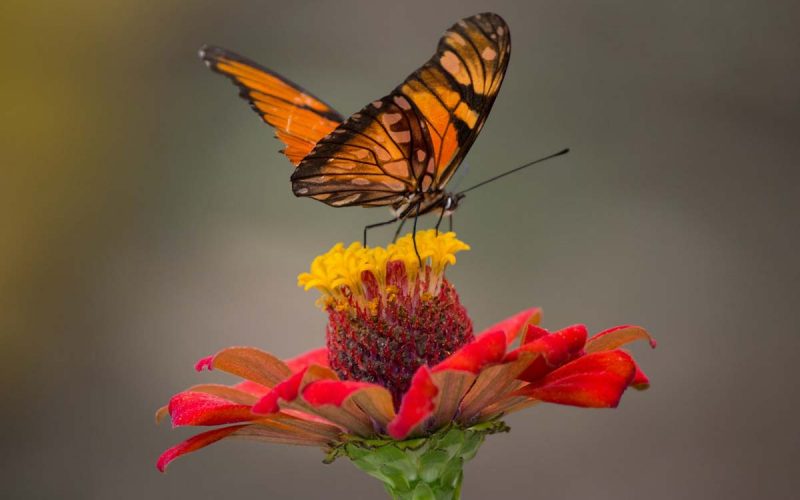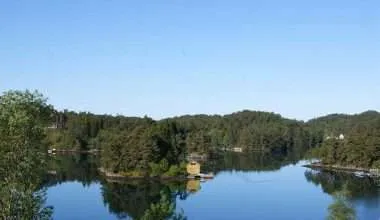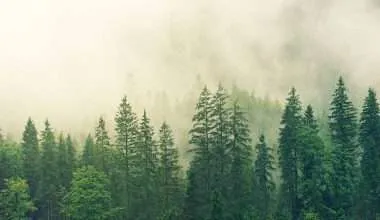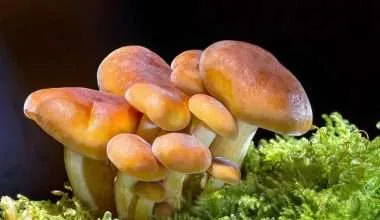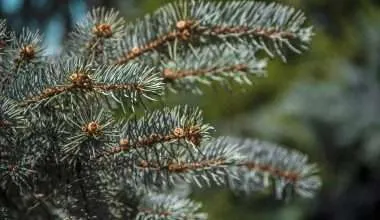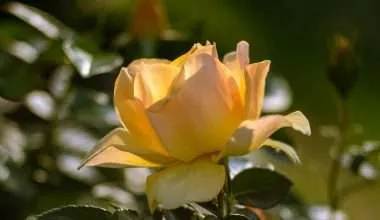Table of Contents Show
At some point in time, you may have faced some allergies. When you search or learn about allergy causes, you’ll realize pollen is one of them.
At this point you’re probably wondering;
Hey! What’s Pollen?
Or if you’ve searched extensively, What’s Pollination?
We’ll discuss that and more throughout this article.
Spoiler: Pollen is not such a bad guy it seems to be!
Navigation:
Example of Pollination with Bees
Environmental benefits of Pollination
- Improved Biodiversity
- Water cycle regulation
- Cleans Drinking Water
- Nutrition Benefits
- Carbon sequestration
- Ethnobotany
What is Pollination?
Pollination is a process where pollen grains are transferred from one flower (stamen-part) to another (pistil-part). It’s an integral part of plant reproduction. The process makes new seeds to produce new plants.
The male part of a flower (stamen) produces tiny sticky particles called pollen. The female part of a flower (pistil) receives pollen on its top part (stigma).
The stigma is also quite sticky, so as to grab pollen. The seeds will be made at the bottom of pistil, known as ovule (egg).
Ever wondered about Pollination vs Fertilization differences? Well the following definition will clear it up, I hope.
What is Fertilization?
When a pollen grain reaches stigma, it makes a pollen tube through the pistil of the flower. The male gamete from pollen passes through this tube and reaches the female gamete (egg) in ovule of the flower. Fusion of the two gametes to make a seed is known as fertilization.
Once fertilization has happened, seeds and fruits can be made.
You see, pollination and fertilization are two steps. Both need to occur so seeds can be made. Only successful transfer of pollen will allow fertilization to take place.
Now back to pollination!
Types of Pollination
As we discussed the process of pollination, there are also a two major types of pollination you should know.
When pollen transfers from stamen to stigma of the same plant, it’s known as self-pollination. Self-pollination occurs when a flower has both male and female parts.
Plants having flowers of single sex have to rely on cross-pollination.
When pollen transfers from stamen of one plant to stigma of another plant, it’s known as cross-pollination. This is generally better of the two.
Note: Pollination requires that plants be of same species.
For example, only pollen from rose can pollinate another rose flower. Pollen from peach tree or daisy flower would not work.
Learning Pollination Process
Pollination is of crucial importance. It helps in production of fruits for us to eat. It also makes more seeds which will create more plants. Additionally, it promotes biodiversity!
Insects are the most important species when it comes to pollination. They act as “pollinators” or pollination agents. Their job is to transfer pollen from one flower to another.
To my surprise and probably yours, pollinators don’t know they’re acting as pollinators!
Pollinators don’t usually know if they are transferring a pollen grain or not. They come to the flower to find food, but accidentally pick up and transfer the pollen from one flower to another.
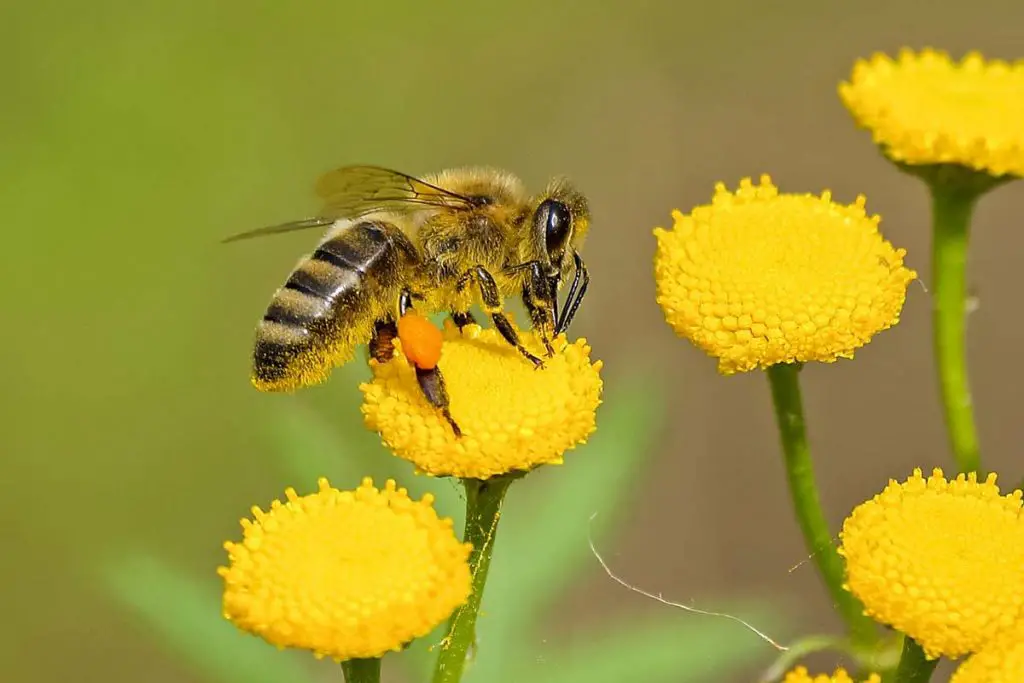
Pollination by Bees
Here is a small example of how bees transfer pollen.
Honeybees are hairy. While they are feeding on pollen or nectar; pollen grains stick to tiny hair located on their bodies and transfer pollen.
They actually carry the pollen grains in specialized legs called “corbicula” that is surrounded by stiff hairs.
This pollen will be transferred to female parts of a flower. Once this happens, it begins to grow a pollen tube fertilization occurs. Once enough pollen is transferred large fruits can be grown and seeds can be produced.
Honeybees visit flowers to get food, they collect the flower’s nectar to bring it back to the beehive and make honey.
Honeybees, butterflies and other insects like moths use their long mouthparts to reach deep into the flowers and extract as much nectar as possible.
Some bees don’t have hair or specialized pollen baskets. Instead, they consume pollen and take it back to their nests. Bees travel large distances and carry hundreds of pollen grains to feed their younger ones.
Wind is also an important source of pollination. Strong winds can blow pollen for long distances, transferring them to flowers outside of insect reach.
Due to honeybees’ role in pollen transfer, they are known as pollinators! And because of their benefits, farmers practice beekeeping for pollination.
What are pollinators?
Pollinators are organism that aid in transfer of pollen from the male part of the flower to the female part of the flower. Once the transfer of pollen takes place, the next step is fertilization!
Pollination by Insects is crucial in production of healthy crops.
Those crops can be good for fibers, food, edible oils, medicines, and other various products. The different commodities produced through pollinators help to generate significant income for farmers.
This is why pollinators are an essential component of any habitat or ecosystem. They strengthen the area on which many wild animals depend for food and shelter.
Some pollinator facts!
- Pollinators help to increase biodiversity
- Population of pollinators can determine the overall health of the ecosystem
- Some crops such as blueberries and cherries, heavily rely on pollinators like honey bees
- 90% of the United States’ apple trees are pollinated by bees
- Approximately 1,000 plants grown worldwide for food, fibers, spices, beverages, and medicine rely on pollination by animals to produce these goods.
Examples of Pollinators
Honey bees are the animal that comes to mind when you think about pollinators. But there are other various others!
Those include insects like bee species, butterflies, beetles, and flies. Some bird species and bats (mammal pollinators) are known to pollinate. About 30,000 species of flowers rely upon pollinators for fertilization!
New plants (in return) help to support a diverse population of pollinators. There are about 1000 species of vertebrate pollinators and an estimated 16,000 different bee species which pollinate on earth.
Vertebrate pollinators include lizards, mice and bats.
Environmental benefits of Pollination
Pollination plays a key role in normal functioning of an ecosystem. This is exactly like keystone species maintaining ecosystems.
Plants being pollinated by diverse pollinators and pollen grains are much healthier and produce larger and more nutritious fruits, with higher yields. This way they serve in generating various sources of nutrition for many different species.
However, pollination plays various other roles in ecosystems. These include purification of water, organic matter degradation, and carbon sequestration. All of these are important for wellbeing of humans on the planet.
Let’s see some of the positive environmental impacts of pollination.
1. Improved Biodiversity
Biodiversity allows ecosystems to be more productive, resilient, and healthier (Here’s how). If pollination doesn’t occur, there would be diminished biodiversity of flowers, crops, trees, and grasses.
A huge fraction of our food would cease to exist if there was no more pollination!
Furthermore, vast majority of animals and insects that rely on food that comes from pollinating trees of apples, onions, cherries, potatoes and more.
They will also cease to exist when they can’t find enough food to eat. Agricultural Biodiversity also prevents insects from targeting a single fruit species.
Here’s how you can protect and conserve biodiversity!
2. Water cycle regulation
The water cycle is made of many complex processes, one of which involves the plants returning the moisture from the soil to the atmosphere via transpiration.
The transpiration by plants, make up 10% of total moisture content in atmosphere. Rest comes from evaporation of water in oceans, rivers and lakes.
Therefore it is necessary to have a large number of plants and trees can transpire moisture back into the atmosphere.
Intact forests are therefore vital in controlling the local climate. They contribute to cloud formation and terrestrial rainfall.
3. Cleans Drinking Water
Good vegetation cover slows down surface water runoff. Plants and trees also prevent soil erosion as they anchor the soil from strong winds and water flow.
Additionally, decreasing water runoff from the land also helps to replenish groundwater levels by allowing more rainwater to be soaked up through the soils and be stored in groundwater reservoirs.
During this process, the water goes through various layers of soil which filter compounds, microbes, and heavy metals from it.
This hydrological process is an essential natural phenomenon to purify water. This way it will be safe when people pump groundwater to the surface and use it for drinking.
4. Nutrition
Research has claimed that the decline of pollinators has a direct relationship with availability of key nutrients including minerals and vitamins in food products.
98% of vitamin C (Ascorbic Acid) comes from vegetables and fruits that are dependent on pollinator species. Vitamin A, that helps to improve vision, is also an essential vitamin found in 70% of all pollinated plants.
Along with vitamins, minerals are also important. They are found in nuts or vegetables and are an integral part of our diet.
An ecosystem with healthy pollination and pollinators ensures maintenance of vitamins and minerals in fruits and vegetables to provide a balanced diet.
5. Carbon sequestration
80% of all flowering plants require pollination. That’s how they reproduce!
If pollination (or pollinators) ceases to exist, most of the flowering plants will vanish. Just a small fragment of these plants will be left on earth. This ultimately means less amount of carbon being sequestered.
Flowering plants, just like normal plants use carbon dioxide to carry out photosynthesis and make oxygen and energy for themselves.
This utilization of carbon is essential as it can be used to reduce carbon emissions of the planet and provide us with ample oxygen to breathe.
6. Ethnobotany
Ethnobotany is the study of ways in which native plants have been able to shape different cultures over the years.
It shows the wisdom of our ancestors in co-existence of humans with other living creatures on this planet.
The process of pollination is important in development of cultural practices related to plants.
